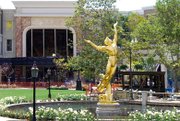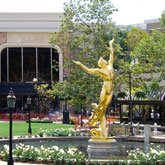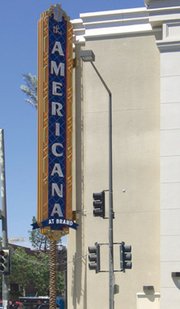The Americana Debuts: New Opportunities for L.A. Region
Even in a weak economy, Vickie McConnell believes that The Americana at Brand could bring a much-needed shot of business to what some might call a sleepy town.
The $400 million project will debut May 2 in downtown Glendale, Calif., a community located about 11 miles north of Los Angeles’ City Hall. It will be the largest retail center as well as the first luxury apartments and condominiums developed by Caruso Affiliated, the company that helped popularize lifestyle retail centers by building The Grove in Los Angeles.
With luxury retailers such as Barney’s New York Co-Op and Tiffany & Co. opening at The Americana, Mc-Connell anticipates a crowd of new people might discover her Fast Frame store, located a few blocks away from The Americana and the Glendale Galleria, a neighboring retail center. Crowds of more than 20 million people are expected to shop at The Americana annually, and many businesses in the neighboring community are hoping to see traffic travel beyond the mall.
“Something needed to happen to Glendale,” McConnell said. “It will rejuvenate downtown.”
Glendale, a city of 207,157, has been better known as the address for the corporate headquarters of International House of Pancakes and Nestleacute; USA, as well as the home to the largest population of Armenians outside of Armenia. The median annual income of its residents is $51,308.
Despite the presence of the Glendale Galleria—which is anchored by Macy’s, Nordstrom, Target and JCPenney—the city and well-off neighboring cities Pasadena and Burbank are under-retailed, according to retail analyst George Whalin.
“There are not a lot of upscale malls out there. And is there another part of Southern California that does not have more old money than Pasadena?” said Whalin, who has been investigating California’s retail scene since 1986, when he started Carlsbad, Calif.–based Retail Management Consultants.
Americana developer Rick Caruso thinks his 15.5-acre park-like retail center will draw people living in the Pasadena area and the communities located along the 101 Freeway, one of the major arteries of the towns in the San Fernando Valley.
“You got a lot of people with a lot of disposable income, but they had no place to shop,” Caruso said.
Luxury shoppers had visited the Old Pasadena section of neighboring Pasadena and Westfield Topanga in Canoga Park, 22 miles northwest of Glendale. However, the city of Glendale has forecasted a windfall of tax revenue from The Americana. The retail center will generate $1.8 million in sales tax annually and $1.8 million in property taxes annually, according to Ritch Wells, a representative for the city of Glendale.
Since the green light was given to The Americana, more developers have shown interest in the city. Glendale’s director of planning, Philip Lanzaframe, said several projects are currently being designed, including mixed-use developments with names such as The Alexander and Verdugo Gardens. These projects will focus on residential units. However, they will devote 4,000 to 8,000 square feet to service businesses such as restaurants and dry cleaners. There is no scheduled construction date for the mixed-use developments.
The city is in talks with Glendale Galleria owner General Growth Properties Inc. on a possible remodel of the mall’s exterior, but the Galleria’s management declined to be interviewed for this story. There is no construction date set for the possible remodel.
The debut of The Americana follows the resolution of a long legal and political saga between General Growth and Caruso. In 2004, General Growth supported a Glendale municipal referendum to halt development of The Americana. The referendum was defeated.
In November 2007, a Superior Court jury ordered the owner of the Glendale Galleria to pay $15 million in punitive damages to Caruso. Caruso accused General Growth Properties Inc. of illegally threatening to shut out the Cheesecake Factory after the restaurant chain showed interest in opening at The Americana.
Along with the Caruso and General Growth centers, Lanzaframe said he also anticipates more independent retail to open around Glendale’s Brand Boulevard, which runs along one side of The Americana and serves as the city’s central retail hub.
Glendale is ripe for more fashion retail, according to Larry Kosmont, president of Encino, Calif.–based real estate advisers Kosmont Cos. According to Kosmont, The Grove helped spark a wave of fashion retail in some streets neighboring the lifestyle mall, including Los Angeles’ stylish West Third Street.
“Fashion needs a destination customer, and [The Grove] attracted new people to the area,” he said. If The Grove had not opened in the Fairfax area, streets such as West Third might have remained dominated by traditional neighborhood retail such as dry cleaners, he added.
West Third Street boutique owner Alisa Loftin echoed Kosmont’s assessment about her street. “It was slowly developing in [a fashion] direction. But with The Grove, it just boomed,” said Loftin, who co-founded fashion boutique Aero & Co.
The Americana promises to be unique. After the May 2 opening, Caruso will take offers for the 100 condominiums and 238 luxury apartments built above the retail center’s stores and restaurants. A loft’s rent will go for $2,000 a month. Monthly rent for a townhouse is expected to be $5,500. The architecture is inspired by classic retail thoroughfares such as Newbury Street in Boston and New Orleans’ French Quarter.
The Americana will also be a study in contrasts. Its park-like green area is dominated by an 18-foot, 23-karat-gold statue called “Spirit of American Youth.” A junglegym area for children will be located on the opposite end of the green.
The mall will host a three-story Barnes & Noble bookstore. Its fashion retail will range from popular-priced fast fashion such as H&M and Forever 21’s XXI to contemporary brands True Religion and Custo Barcelona. Other stores will include BCBG Max Azria, Calvin Klein, Chico’s, Cole Haan, Juicy Couture, Michael Stars, Planet Funk and Peter Alexander.
Although the neighboring Galleria offers more than three traditional department-store “anchors,” the Americana did not seek traditional anchor stores, according to Caruso. Instead, it will attract consumers with “mini-anchors” such as Barnes & Noble. Caruso said a mall without a traditional anchor has a good chance of success. “You can’t depend on anchors being available,” he said. “If you have good mini-anchors—such as Barnes & Noble, Cheesecake Factory, Crate & Barrel—you have the start of a strong center.” Caruso plans to have luxury retail tenants at his The Shops at Santa Anita, an upcoming retail center located in Arcadia, Calif., 13 miles east of Glendale. “We don’t want to duplicate Rodeo Drive,” he said. “We will have luxury retailers, but it’s going to be a mix.” Caruso expects to start construction on The Shops at Santa Anita perhaps by 2009.


























